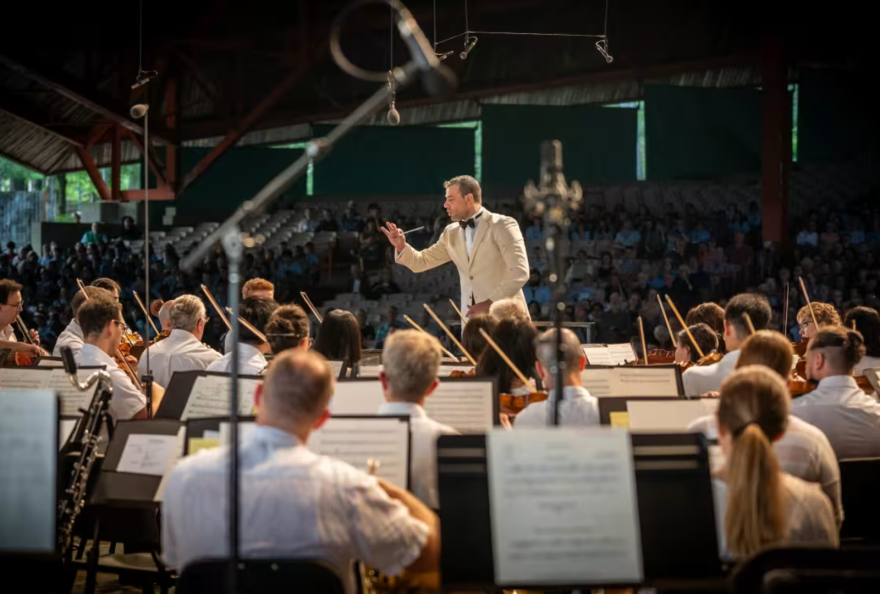This weekend, Interlochen Center for the Arts hosts two major classical concerts celebrating a 99-year partnership with the Detroit Symphony Orchestra.
On Saturday, the Detroit Symphony Orchestra performs at Interlochen’s Kresge Auditorium with works by Rhiannon Giddens and Michael Abels, Paul Dukas’s "The Sorcerer’s Apprentice" and Nikolai Rimsky-Korsakov’s "Scheherazade."
On Sunday, DSO musicians return for a special side-by-side concert with the World Youth Symphony Orchestra, featuring George Gershwin’s "Porgy and Bess" and Florence Price’s Symphony No. 3.
Despite the intensity of the repertoire, Bignamini finds motivation in his young collaborators.
"I receive a lot of energy from these young musicians. It's very demanding, because the program is pretty challenging," he says. "This is a very big opportunity for me and for my musicians to share the stage with the next generation."
The DSO–Interlochen connection dates back to 1926, when Detroit’s Orchestra Hall welcomed the National High School Honors Orchestra, a forerunner to Interlochen Arts Camp.
Since then, their collaboration has flourished through performances, mentorship and education. Presently, 18 DSO members are proud Interlochen alumni.
In a recent visit to Interlochen Public Radio, Bignamini sat down with Classical IPR's Amanda Sewell to discuss this weekend's concerts.
Attend the concerts in person or listen to the live broadcast on Classical IPR.
On Saturday and Sunday, Classical IPR's pre-shows begins at 7:00 p.m ET; downbeat and our live broadcasts start at 7:30 p.m. ET.
Enjoy Jader Bignamini's full interview with Classical IPR's Amanda Sewell by clicking "Listen" above, or read the edited transcript below.

Amanda Sewell: Welcome to Studio A at Interlochen Public Radio. I'm Amanda Sewell. I'm joined today by Jader Bignamini, the music director of the Detroit Symphony Orchestra.
Jader Bignamini: Hello everyone. I'm so happy to be here.
AS: We are so glad to have you and the Detroit Symphony Orchestra back on Interlochen’s Campus for your annual summer residency. Let's talk about the Detroit Symphony Orchestra program.
The three pieces that DSO are playing on that program are just masterpieces of orchestral color and storytelling. I love the program already and I haven't even heard it. Let's start with "Omar" Overture by Rhiannon Giddens and Michael Abels. This is a piece that's newer to me, and probably going to be newer to the audience.
JB: Michael Abels is one of my favorite contemporary composers. He's a composer in residence in Detroit, I strongly wanted him in Detroit. I love his music. He has incredible talent and he's a very nice and smart person.
"Omar" Overture is a very enjoyable piece with an African atmosphere, and features special instruments like the African drum, the djembe. And, there is an incredible solo in the viola part. Our principal violist, Eric Nolan, is incredible and is one of the best violists in the world. I'm lucky to have him in Detroit.
AS: Now the rest of the program has two more beloved pieces on it, "The Sorcerer's Apprentice" and "Scheherazade." Now, are the bassoons ready for "The Sorcerer's Apprentice?" This is "the" bassoon piece.
JB: True. And, every time we do auditions for bassoon, we have them play this part because it's very, very important. Every time I have the opportunity to conduct this piece, my mind goes to Disney's "Fantasia."
AS: Yes, with Mickey Mouse!

JB: Yeah, exactly. It is a very good piece. And sometimes people think that it's easy, but it is an extremely difficult piece and a little challenging every time. Maybe not for the DSO, because they are great.
AS: So we start the program with the "Omar" Overture, which features the viola prominently. We have "The Sorcerer's Apprentice," which stars the bassoon. And then finally on the program we have "Scheherazade" by Rimsky-Korsakov. It's not technically a violin concerto, but it is almost. Interlochen alum Kim Kennedy, who is the associate concertmaster, will be playing the part of Scheherazade.
JB: It's an incredible piece and I think everyone will like this masterpiece. Kim plays the solo part extremely well. She has an incredible talent and she is so dedicated to the music.
The trickiest part is that we have two melodies in the whole piece. Rimsky-Korsakov was able to compose 40 minutes of music with two melodies, and every time it sounds like a new melody. He was an incredible master of composition, and he knew every instrument.
The finale is so fast and the musicians enjoy that moment and every moment. I enjoy their energy as they enjoy making music together.
AS: Now let's talk about the Sunday night concert, the side-by-side with the World Youth Symphony Orchestra, and members of the Detroit Symphony Orchestra. I'll be honest, this is one of my favorite concerts every summer. When you have the DSO musicians side-by-side with the high school musicians, how do the DSO musicians feel about this arrangement?
"This is a very big opportunity for me and for my musicians to share the stage with the next generation. I'm very happy to give them all my energy. "DSO music director Jader Bignamini
JB: They are extremely happy. They want to do this event, and also, they are very happy to have the opportunity to give masterclasses for the young musicians before the concert.
The best part for me is rehearsals, when you hear all of them, my musicians and the young musician together. And, you can feel that the DSO musicians want to share every detail with the young musicians. Every time we begin rehearsal, in the first few minutes, I can see the faces of the young musicians, because they have these great musicians by their side.
But, a few minutes later, everything changes because my musicians love to play with these students, and want to make them feel comfortable. They don't want to play alone, they want to play together with them.
I see my musicians encouraging the students, telling them: “please play more... you can do it.” This is the right attitude — to enjoy the music and to have the opportunity to absorb part of the knowledge that they have.
AS: One thing that's so impressive about this side-by-side concert is that the solos are always played by the student musicians.
JB: Of course.
AS: The DSO folks pretty much take a backseat.
JB: Well, this is the meaning of the concert. They support them. They try to help them if they need some help, but the goal is that they have to play their own part.
Maybe they can give them some suggestions or little tricks to play something in a different way. But, the idea of the concert is that WYSO musicians play their parts, and my musicians support them.
AS: What is it that keeps you and the DSO coming back to Interlochen every year?
JB: This is a very big opportunity for me and for my musicians to share the stage with the next generation. I'm very happy to give them all my energy.
Every day this week, I receive a lot of energy from these young musicians. It's a very demanding week, because the program is pretty challenging.
I'm always so surprised when [the DSO musicians] arrive at the end of the week. The ensemble grows very fast, and they are very happy to absorb everything from me. I'm very happy knowing that I'm helping them for sure, but they also give me a lot of energy in return, and this is the most important part of my job.
AS: It is a different process than working with a professional orchestra?
JB: It is different, but not totally different. Of course, the process is more or less the same. However, I do have to explain some details to a young musician because they don't have experience. But, I hope that after this week they have more experience than before.

I like to involve everyone in the literature of the piece, and the culture. It's very interesting. And I hope it is a helpful process for them and for me too.
AS: For these musicians in the World Youth Symphony Orchestra, most of them are playing these pieces for the first time in their lives, and they don't come in with any preconceived notion of how they might play them compared to the professionals who might have played them several times.
JB: That is probably the most important point of the process during rehearsal. This week we have Gershwin's "Porgy and Bess" and Price’s symphony number three. Of course, "Porgy and Bess" is a very demanding piece. But, they have an idea about how to approach the music. This kind of music is more present in their culture than mine for sure. The preparation process is a little easier in "Porgy and Bess" than in Price’s symphony number three.
The symphony is a pretty uncommon piece. I'm lucky because I had the opportunity to conduct this piece in Detroit with my orchestra and I studied the piece very deeply. And with the young musicians, I explain everything, the style and the kind of sound we have to have in this kind of music. It is a very interesting process that I think they enjoy. I hope they like the challenge, and after this week, they will be different players.
AS: Yes, playing a Price symphony takes a different ear, I suppose, than a Beethoven symphony, Mahler symphony, or Rachmaninoff symphony.
JB: Yes, of course. They have to understand that every symphony and type of music has a different style and sound too. For example, if we have to play fortissimo in "Porgy and Bess," it is not the same as in the Price, Mahler, or Beethoven. And, bow techniques, crescendos or decrescendos are very different for every composer and musical time period.
This is the goal. They have to understand the differences between different composers and different music styles. "Porgy and Bess" is American music, but it's completely different from Price’s Symphony which is also American music. The mood and feeling is completely different. I am trying to share with them all of these things.
AS: What's fascinating too is that the "Porgy and Bess" suite and the Price symphony were composed within five or ten years of each other. They're near contemporaries, and yet they're so different .
JB: Yes, it’s very interesting that they are more or less in the same musical time period, but it seems like two different worlds
AS: Thank you so much for talking with us today!
JB: Thank you. It was a joy.









